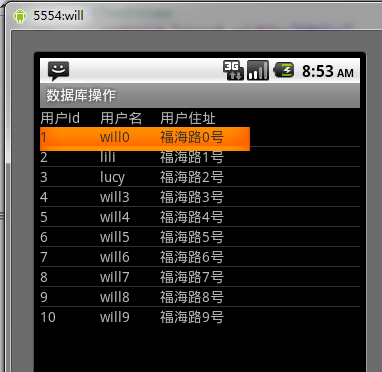您好,登錄后才能下訂單哦!
您好,登錄后才能下訂單哦!
小編給大家分享一下Android中如何實現SQLite事務處理結合Listview列表顯示功能,相信大部分人都還不怎么了解,因此分享這篇文章給大家參考一下,希望大家閱讀完這篇文章后大有收獲,下面讓我們一起去了解一下吧!
具體如下:
前面的文章里介紹過事務的特點如原子性,隔離性,一致性,持久性。下面就結合Android的sqlite來說下,這次的文章里會把listview也結合起來用。實際上android里的事務和我們數據庫里的是一樣的。也是開啟事務,操作,提交事務。如果出現問題就回滾。
public void Transaction(){
SQLiteDatabase database=db.getReadableDatabase();
database.beginTransaction(); //開啟事務
try{
String sql1="update student set username='lili' where userid=2";
String sql2="update student set username='lucy' where userid=3";
database.execSQL(sql1);
database.execSQL(sql2);
database.setTransactionSuccessful(); //設置事務的狀態,這句不寫事務就會回滾
}finally{
database.endTransaction(); //結束事務
}
}上面這段代碼就是一個簡單的事務操作,需要注意的就是要捕獲異常,這樣事務就會被結束掉可以節約數據庫資源。
事務的操作就是這樣,下面就介紹下listview的使用,我們理解成列表就可以了。界面如下

我們可以把這個界面拆成2個,主界面就只有“用戶id”,“用戶名”,“用戶住址”也就是列表的頭,主界面如下
<?xml version="1.0" encoding="utf-8"?> <LinearLayout xmlns:android="http://schemas.android.com/apk/res/android" android:orientation="vertical" android:layout_width="fill_parent" android:layout_height="fill_parent" > <LinearLayout xmlns:android="http://schemas.android.com/apk/res/android" android:orientation="horizontal" android:layout_width="wrap_content" android:layout_height="wrap_content"> <TextView android:layout_width="60dip" android:layout_height="wrap_content" android:text="用戶id" /> <TextView android:layout_width="60dip" android:layout_height="wrap_content" android:text="用戶名" /> <TextView android:layout_width="60dip" android:layout_height="wrap_content" android:text="用戶住址" /> </LinearLayout> <ListView android:layout_width="fill_parent" android:layout_height="wrap_content" android:id="@+id/listview" /> </LinearLayout>
這里的listview要定義一個id提供后面數據綁定使用,含有內容的顯示界面也比較簡單,也就是幾個textview
<?xml version="1.0" encoding="utf-8"?> <LinearLayout xmlns:android="http://schemas.android.com/apk/res/android" android:orientation="horizontal" android:layout_width="wrap_content" android:layout_height="wrap_content"> <TextView android:layout_width="60dip" android:layout_height="wrap_content" android:id="@+id/userid" /> <TextView android:layout_width="60dip" android:layout_height="wrap_content" android:id="@+id/username" /> <TextView android:layout_width="90dip" android:layout_height="wrap_content" android:id="@+id/address" /> </LinearLayout>
這樣界面的部分就OK了,接下來就是讀取數據了,之后顯示在listview中,在這里就提供2種方法來顯示數據
(1)方法1
package org.lxh.db;
import java.util.*;
import org.lxh.service.StudentService;
import org.lxh.vo.Student;
import android.app.Activity;
import android.database.Cursor;
import android.os.Bundle;
import android.view.View;
import android.widget.AdapterView;
import android.widget.AdapterView.OnItemClickListener;
import android.widget.ListView;
import android.widget.SimpleAdapter;
import android.widget.SimpleCursorAdapter;
import android.widget.Toast;
public class DBActivity extends Activity {
private StudentService service;
public void onCreate(Bundle savedInstanceState) {
super.onCreate(savedInstanceState);
setContentView(R.layout.main);
this.service=new StudentService(this);
ListView view=(ListView)this.findViewById(R.id.listview);
List<Student> all=this.service.fiandAll();
List<HashMap<String,Object>> data=new ArrayList<HashMap<String,Object>>();
//逐個取出元素
Iterator<Student> it=all.iterator();
Student stu=null;
while(it.hasNext()){
stu=new Student();
stu=it.next();
HashMap<String,Object> map=new HashMap<String,Object>();
map.put("userid", stu.getUserid());
map.put("username", stu.getUsername());
map.put("address", stu.getAddress());
data.add(map);
}
//數據綁定
SimpleAdapter adapter=new SimpleAdapter(this, data, R.layout.listview, new String[]{"userid","username","address"},new int[]{R.id.userid,R.id.username,R.id.address});
view.setAdapter(adapter);
//添加列表項監聽事件
view.setOnItemClickListener(new OnItemClickListener(){
public void onItemClick(AdapterView<?> parent, View view,int position, long id) {
ListView listview=(ListView)parent;
HashMap<String,Object> hash=(HashMap<String,Object>)listview.getItemAtPosition(position);
Toast.makeText(DBActivity.this, hash.get("userid").toString(), 1).show();
}});
}這里的數據綁定,使用的是SimpleAdapter,我們首先要做的就是把數據逐個取出來存入一個HashMap,如下所示
HashMap<String,Object> map=new HashMap<String,Object>();
這里的hashmap存儲的是泛型數據,這個集合的泛型不能隨便修改,接下來的工作就是把這個集合當做list的泛型
List<HashMap<String,Object>> data=new ArrayList<HashMap<String,Object>>();
最后要記得把這個map添加到集合里
對于
SimpleAdapter adapter=new SimpleAdapter(this, data, R.layout.listview, new String[]{"userid","username","address"},new int[]{R.id.userid,R.id.username,R.id.address});
view.setAdapter(adapter);第四個參數里的"userid","username","address"是map集合里的key,最后一個參數是textview,也就是數據界面里的textview.后面還加了個監聽,只要點擊textview就會顯示用戶id,android就會通過textview的位置讀取內容。
這里把先讀數據的代碼先貼出來
public List<Student> fiandAll(){
List<Student> all=new ArrayList<Student>();
String sql="select * from student";
SQLiteDatabase database=db.getReadableDatabase(); //使用getReadableDatabase取得SQLiteDatabase
Cursor cursor=database.rawQuery(sql, null); //得到游標,類似resultset
Student stu;
while(cursor.moveToNext()){ //移動游標
int id=cursor.getInt(cursor.getColumnIndex("userid"));
String name=cursor.getString(cursor.getColumnIndex("username"));
String address=cursor.getString(cursor.getColumnIndex("address"));
stu=new Student();
stu.setUserid(id);
stu.setUsername(name);
stu.setAddress(address);
all.add(stu);
}
cursor.close(); //關閉游標
return all;
}(2)游標適配器
下面是讀數據的代碼
public Cursor fiandAllCursor(){
List<Student> all=new ArrayList<Student>();
String sql="select userid as _id,username,address from student";
SQLiteDatabase database=db.getReadableDatabase(); //使用getReadableDatabase取得SQLiteDatabase
Cursor cursor=database.rawQuery(sql, null); //得到游標,類似resultset
//cursor.close(); //這里不可以關閉游標
return cursor;
}這里為主鍵的列取了別名是因為android內部建議主鍵設置為_id,但是不可能每個表的主鍵的名稱都是_id
Cursor all=this.service.fiandAllCursor(); //使用游標適配器
SimpleCursorAdapter cadapter=new SimpleCursorAdapter(this, R.layout.listview,all, new String[]{"_id","username","address"},new int[]{R.id.userid,R.id.username,R.id.address});
view.setAdapter(cadapter);
//添加列表項監聽事件
view.setOnItemClickListener(new OnItemClickListener(){
public void onItemClick(AdapterView<?> parent, View view,int position, long id) {
ListView listview=(ListView)parent;
Cursor hash=(Cursor)listview.getItemAtPosition(position); //取得被點擊item的位置
int temp=hash.getInt(hash.getColumnIndex("_id"));
Toast.makeText(DBActivity.this, String.valueOf(temp), 1).show();
}});這里的適配器參數順序和上面的有點不同,而且第四個參數里的“usernam”,"address"和'_id'都是表的列名。其他地方沒太大區別,上面的“_id”也不能寫成別的。否則會出錯
以上是“Android中如何實現SQLite事務處理結合Listview列表顯示功能”這篇文章的所有內容,感謝各位的閱讀!相信大家都有了一定的了解,希望分享的內容對大家有所幫助,如果還想學習更多知識,歡迎關注億速云行業資訊頻道!
免責聲明:本站發布的內容(圖片、視頻和文字)以原創、轉載和分享為主,文章觀點不代表本網站立場,如果涉及侵權請聯系站長郵箱:is@yisu.com進行舉報,并提供相關證據,一經查實,將立刻刪除涉嫌侵權內容。